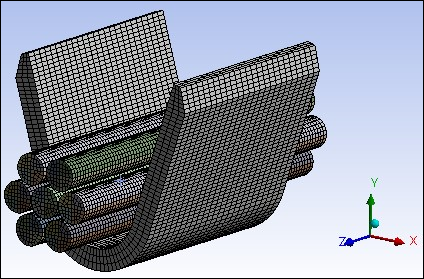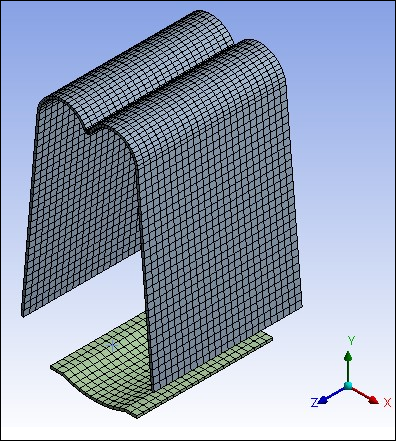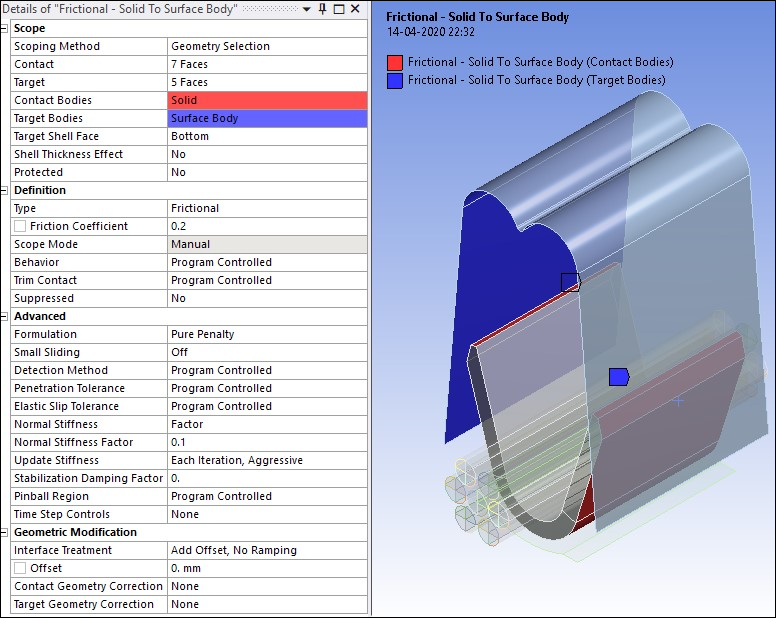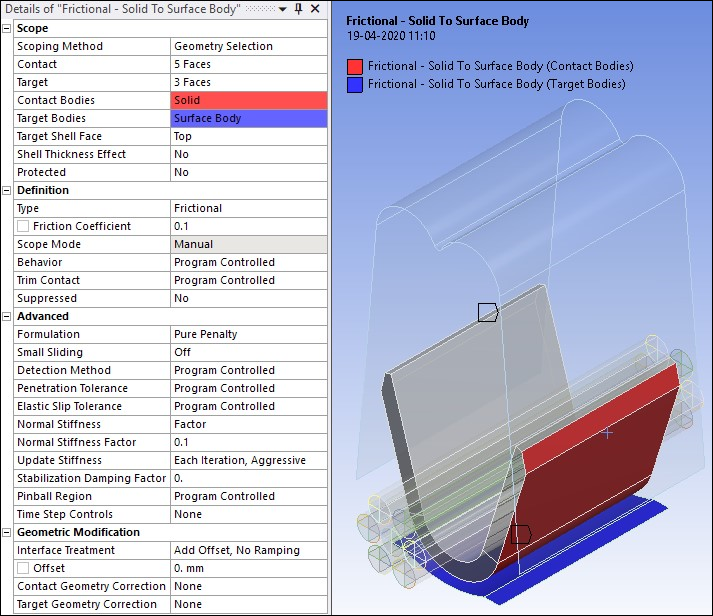The 3-D crimp joint model consists of a 0.5 mm thick grip and seven stranded wires, with each wire has a 0.725 mm diameter. The grip and wires are made of a copper alloy which is modeled by the multi-linear isotropic hardening plasticity material model. The model also includes a rigid punch and a rigid support.
The steps to create this model are broken down as follows:
The grip and the seven stranded wires are modeled with SOLID186 (3-D structural solid) elements. Face sizing of 0.1 mm with hard behavior is assigned to three faces of grip body at location Z = 5 mm. Edge sizing of twenty-five divisions with hard behavior is assigned to ten edges of grip body along z direction. Body sizing of 0.1 with hard behavior is assigned to all twenty-eight wire body parts. (For information on sizing control, see Notes on Element Sizing).
A thickness of 0.1 mm is assigned to rigid punch and base support bodies and their Stiffness Behavior is set to Rigid. The rigid punch and rigid base supports are modeled with TARGE170 (3-D target segment) elements. Body sizing of 0.25 mm with hard behavior is assigned to the rigid punch and base bodies. Edge sizing of six divisions with hard behavior is used on the top small curved face of rigid punch. Edge sizing of twenty divisions with hard behavior is assigned to two top large curved faces of the rigid punch. Face meshing is applied to all eight faces of the Rigid Punch and Base Support.
The rigid target surfaces are taken from a pair-based contact model and converted to general contact. To include these target
surfaces in the general contact definition,
a zero real constant ID and a zero material ID are assigned via the
EMODIF command with I1 = GCN. A
unique section ID (SECNUM) and a unique element type ID
(TYPE) are also assigned using the EMODIF
command. The same ID number is used for the section and element type IDs. (For more
details, see Geometry Correction for Contact and Target Surfaces). The following command snippet shows
the commands used to define the rigid punch as a general contact surface since there
is no option for setting this in the Mechanical Application.
/prep7 ! Defining the rigid punch as a general contact surface allsel,all esel,s,type,,32,34,2 edele,all,all allsel,all edele,66268 edele,69299 esel,s,type,,36 emodif,all,type,33 esel,s,type,,51 emodif,all,type,35 allsel,all esel,s,type,,33 ! Select the existing rigid surface for the punch emodif,all,secnum,33 ! Assign a unique section ID (same as type ID) emodif,all,real,gcn ! Assign a 0 REAL ID by inputting the GCN label emodif,all,mat,gcn ! Assign a 0 MAT ID by inputting the GCN label ! Defining the rigid base as a general contact surface esel,s,type,,35 ! Select the existing rigid surface for the base emodif,all,secnum,35 ! Assign a unique section ID (same as type ID) emodif,all,real,gcn ! Assign a 0 REAL ID by inputting the GCN label emodif,all,mat,gcn ! Assign a 0 MAT ID by inputting the GCN label allsel,all
After building a complete finite element model and defining rigid targets, the
next step is to create general contact
surfaces using the GCGEN command. This command automatically
generates 3-D surface-to-surface elements (CONTA174) on
exterior faces of the base elements and splits them into different contact surfaces
(each having a unique section ID) if the angle between the normal of adjacent faces
is greater than the specified feature angle (GCGEN with
FeatureANGLE = 20). It also generates 3-D line
contact elements (CONTA177) on the feature edges between
split surfaces based on the setting EdgeKEY = 1 on
GCGEN.
The value twenty is used for feature angle in order to achieve the desired split of the contact surfaces and edges between them. In this model, only the top edges of the grip are considered, and the rest are deleted. The following command snippet shows the commands used to generate the contact surfaces as described above since there is no option for this in the Mechanical Application.
allsel,all
gcgen,,20,1, ! Automatically generate CONTA174 elements on
! exterior faces & CONTA177 on feature edges
! Only the top edges of the grip are considered, and the rest are deleted
esel,s,real,gcn ! Select general contact elements
esel,r,ename,,177 ! Reselect the edge elements, CONTA177
esel,u,sec,,95,96 ! Unselect the top edge elements
esel,u,sec,,109,112 ! Unselect the top edge elements
edele,all,all ! Delete the selected edge elements except top
! edge elements
allsel,all
! Define the contact force-based model for CONTA177
keyopt,95,3,0
keyopt,96,3,0
keyopt,109,3,0
keyopt,110,3,0
keyopt,111,3,0
keyopt,112,3,0
In the following command snippet, the contact interactions are defined GCDEF. By default, frictionless standard contact is assumed among all general contact surfaces. To override this default, the command GCDEF,AUTO,ALL,ALL,100,100 defines frictional contact for all contact surfaces. Additional GCDEF commands are used to exclude some surfaces that may cause spurious contact.
! Define interactions between general contact surfaces via the GCDEF command
gcdef,auto,all,all,100,100 ! Define auto asymmetric frictional contact
! among all surfaces defined by material ID 100
mp,mu,100,.1 ! Define friction coefficient for material ID 100
100
tb,inter,100,,,standard ! Define standard contact behavior
tbdata,1,0 ! Include penetration and gap
r,100
rmodif,100,3,1 ! Define FKN for real ID 100
! Exclude contact between some surfaces via the GCDEF command
! to avoid spurious contact
gcdef,exclude,grip_zp_face,all_face
gcdef,exclude,grip_zn_face,all_face
gcdef,exclude,grip_zp_face,all_edge
gcdef,exclude,grip_zn_face,all_edge
gcdef,exclude,gripTop_xn_face,grip_inner_face
gcdef,exclude,75,77
gcdef,exclude,gripTop_xp_face,grip_inner_face
gcdef,exclude,76,79
allsel,all
gcdef,list ! List all defined interactions between general contact
! surfaces
gcdef,table
Frictional contact with a coefficient of friction 0.2 is defined between the rigid punch and grip as shown in the figure below.
The coefficient of friction is set to 0.1 for the frictional contact between the grip and rigid base as shown in the following figure.






